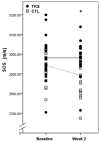Tactile/kinesthetic stimulation (TKS) increases tibial speed of sound and urinary osteocalcin (U-MidOC and unOC) in premature infants (29-32weeks PMA)
- PMID: 22846674
- PMCID: PMC3434881
- DOI: 10.1016/j.bone.2012.07.016
Tactile/kinesthetic stimulation (TKS) increases tibial speed of sound and urinary osteocalcin (U-MidOC and unOC) in premature infants (29-32weeks PMA)
Abstract
Preterm delivery (<37 weeks post-menstrual age) is associated with suboptimal bone mass. We hypothesized that tactile/kinesthetic stimulation (TKS), a form of infant massage that incorporates kinesthetic movement, would increase bone strength and markers of bone accretion in preterm infants. Preterm, AGA infants (29-32 weeks) were randomly assigned to TKS (N=20) or Control (N=20). Twice daily TKS was provided 6 days per week for 2 weeks. Control infants received the same care without TKS treatment. Treatment was masked to parents, health care providers, and study personnel. Baseline and week two measures were collected for tibial speed of sound (tSOS, m/sec), a surrogate for bone strength, by quantitative ultrasound (Sunlight8000) and urine markers of bone metabolism, pyridinium crosslinks and osteocalcin (U-MidOC and unOC). Infant characteristics at birth and study entry as well as energy/nutrient intake were similar between TKS and Control. TKS intervention attenuated the decrease in tSOS observed in Control infants (p<0.05). Urinary pyridinium crosslinks decreased over time in both TKS and CTL (p<0.005). TKS infants experienced greater increases in urinary osteocalcin (U-MidOC, p<0.001 and unOC, p<0.05). We conclude that TKS improves bone strength in premature infants by attenuating the decrease that normally follows preterm birth. Further, biomarkers of bone metabolism suggest a modification in bone turnover in TKS infants in favor of bone accretion. Taken together, we speculate that TKS improves bone mineralization.
Copyright © 2012 Elsevier Inc. All rights reserved.
Figures




Similar articles
-
Review of Randomized Controlled Trials of Massage in Preterm Infants.Children (Basel). 2017 Apr 3;4(4):21. doi: 10.3390/children4040021. Children (Basel). 2017. PMID: 28368368 Free PMC article. Review.
-
Tactile and Kinesthetic Stimulation (TKS) intervention improves outcomes in weanling rat bone in a neonatal stress model.J Musculoskelet Neuronal Interact. 2013 Jun;13(2):157-65. J Musculoskelet Neuronal Interact. 2013. PMID: 23728102
-
Longitudinal measurements of bone status in preterm infants.J Pediatr Endocrinol Metab. 2007 Mar;20(3):415-24. doi: 10.1515/jpem.2007.20.3.415. J Pediatr Endocrinol Metab. 2007. PMID: 17451080
-
Urinary osteocalcin and serum pro-C-type natriuretic peptide predict linear catch-up growth in infants.J Bone Miner Res. 2012 Jul;27(7):1528-35. doi: 10.1002/jbmr.1596. J Bone Miner Res. 2012. PMID: 22407446
-
Effect of tactile/kinesthetic massage therapy on growth and body composition of preterm infants.Eur J Pediatr. 2021 Jan;180(1):207-215. doi: 10.1007/s00431-020-03738-w. Epub 2020 Jul 14. Eur J Pediatr. 2021. PMID: 32666281 Clinical Trial.
Cited by
-
Effect of physiotherapy on the promotion of bone mineralization in preterm infants: a randomized controlled trial.Sci Rep. 2022 Jul 8;12(1):11680. doi: 10.1038/s41598-022-15810-6. Sci Rep. 2022. PMID: 35804078 Free PMC article. Clinical Trial.
-
First Brazilian recommendation on physiotherapy with sensory motor stimulation in newborns and infants in the intensive care unit.Rev Bras Ter Intensiva. 2021 Jan-Mar;33(1):12-30. doi: 10.5935/0103-507X.20210002. Rev Bras Ter Intensiva. 2021. PMID: 33886850 Free PMC article.
-
Review of Randomized Controlled Trials of Massage in Preterm Infants.Children (Basel). 2017 Apr 3;4(4):21. doi: 10.3390/children4040021. Children (Basel). 2017. PMID: 28368368 Free PMC article. Review.
-
Influence of H-HOPE intervention for premature infants on growth, feeding progression and length of stay during initial hospitalization.J Perinatol. 2015 Aug;35(8):636-41. doi: 10.1038/jp.2015.11. Epub 2015 Mar 5. J Perinatol. 2015. PMID: 25742287 Free PMC article. Clinical Trial.
-
Enhancing sensory experiences for very preterm infants in the NICU: an integrative review.J Perinatol. 2017 Apr;37(4):323-332. doi: 10.1038/jp.2016.179. Epub 2016 Oct 20. J Perinatol. 2017. PMID: 27763631 Free PMC article. Review.
References
-
- Greer FR. Osteopenia of prematurity. Annu Rev Nutr. 1994;14:169–85. - PubMed
-
- Fewtrell M. Early nutritional predictors of long-term bone health in preterm infants. Curr Opin Clin Nutr Metab Care. 2011;14:297–301. - PubMed
-
- Fewtrell MS, Williams JE, Singhal A, Murgatroyd PR, Fuller N, Lucas A. Early diet and peak bone mass: 20 year follow-up of a randomized trial of early diet in infants born preterm. Bone. 2009;45:142–9. - PubMed
-
- Chan GM, Armstrong C, Moyer-Mileur L, Hoff C. Growth and bone mineralization in children born prematurely. J Perinatol. 2008;28:619–23. - PubMed
-
- Fewtrell, Prentice A, Cole TJ, Lucas A. Effects of growth during infancy and childhood on bone mineralization and turnover in preterm children aged 8-12 years. Acta Paediatr. 2000;89:148–53. - PubMed
Publication types
MeSH terms
Substances
Grants and funding
LinkOut - more resources
Full Text Sources
Medical
Miscellaneous

